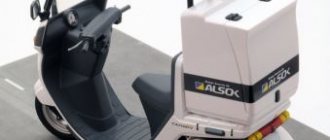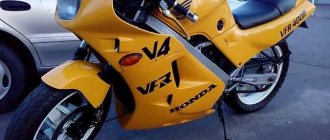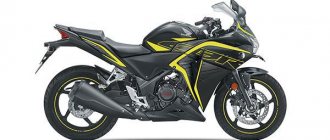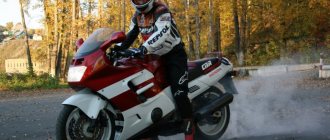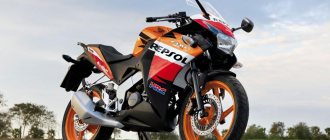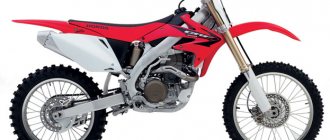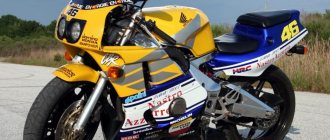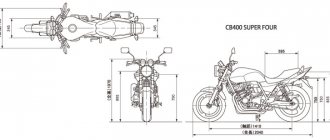CBR 250RR
— Honda motorcycle
The Honda CBR 250 RR sports motorcycle model first appeared in 1986 and was produced until 1996 (the model continued to be sold until 1999). Officially sold only in Japan and Australia, but unofficially imported by other countries.
The Honda CBR250RR was based on the inline 4-cylinder engine from the Honda CBR400RR, reduced to 249 cc. and producing 40-45 hp. (depending on the year of manufacture) power and 21.5-23.5 Nm of torque. Maximum engine performance is achieved at 11,500-14,500 rpm, and maximum speed is 19,000.
The features of the Honda CBR250RR include an aluminum frame and pendulum, a gear timing drive, non-adjustable simple suspension in the form of a conventional telescopic fork and a monoshock absorber (adjustable only by preload), a 6-speed gearbox and 143 kg of dry weight.
The Honda CBR 250 RR model was produced until 1996, after which it was discontinued. In 2011, Honda “resurrected” the once popular model, introducing under its name a budget 1-cylinder motorcycle for beginners - the Honda CBR250R, which was aimed at Asian countries - naturally, it has nothing in common with the Honda CBR250RR.
The concept of small-capacity 4-cylinder motorcycles was widespread in Japan in the 90s, but had to be abandoned quite quickly. The main reason for this was the extremely low engine life due to the heavy load on the elements and very small parts. Subsequently, all Japanese manufacturers switched to 1-2 cylinder small-capacity engines, which were cheaper and had a disproportionately longer service life, although they produced less performance than their 4-cylinder ancestors.
In 2021 there will be a reincarnation of the model of the same name.
Unlike the Honda CBR250R]], the new Honda CBR250RR model has a 2-cylinder engine, inverted forks, electronically controlled throttle and a modern, aggressive appearance.
The basis of the Honda CBR250RR was an in-line 2-cylinder liquid-cooled engine with a volume of 249 cm³ and producing 38 hp. power and 23 Nm of torque. Maximum engine performance at 11000-12500 rpm.
Other features of the motorcycle include a steel frame, an inverted fork, a 6-speed gearbox, a fuel tank for 14, the availability of versions with ABS and a curb weight of 165 kg.
Currently, the Honda CBR250RR (2017) is manufactured in Indonesia and shipped to Asian countries including Japan.
Features of Honda CBR250RR
The CBR250RR acted as the little sister to Honda's line of sports motorcycles.
The second reincarnation was released in 2011 . However, the last “R” disappeared from the name, and the developers themselves announced that this was a model for beginners. It will be offered only in the domestic market, or in Asian countries, if there is demand. However, interest exceeded all expectations, and for 7 years it was offered to beginners all over the world.
The third reincarnation appeared in 2021 . This is already a full-fledged sports bike, no name changes, no newbies. This is a Honda cbr250rr, but taking into account all the requirements for a modern sports bike.
More on reincarnation below.
Comfort
The progressive suspension at the rear makes the ride more enjoyable. It is important to note that previously Japanese bikes could not afford this. Apparently, rider comfort has begun to occupy a more significant position among the priorities of manufacturers from this country. As a result, the bike is comfortable to ride, unless, of course, you use the machine for off-road use.
Like any other sportbike, this is a motorcycle for a good track, and not for rough terrain. It is on the track that it will show its best properties: speed, maneuverability and, at the same time, smooth dynamics. However, the speed here will only impress beginners. But this makes the model a suitable motorcycle for beginners in this class.
Specifications
The developers made the timing drive using gears, having previously tested this solution on a babyblade. The power plant has no other unusual or new solutions.
Engine – right side view.
Engine – left view.
The motorcycle received a 4-stroke engine with 4 in-line cylinders, which gave:
- working volume - 249 cm3;
- power - 45 (40) hp;
- number of valves - 16;
- cylinders - 4;
- cooling - liquid;
- fuel supply - carburetor;
- ignition - transistor;
- start - electric starter;
- fuel tank - 13 l.
According to new Japanese laws that came into force in 1994, the bike's power was reduced to 40 horsepower . The multi-cylinder solution, despite its small volume and budget option, provided one tangible advantage - a minimum of vibrations, and therefore more comfortable movement.
Transmission and clutch
Torque from the engine to the rear wheel is transmitted by a classic chain drive.
The motorcycle was equipped with a 6-speed gearbox. It did not cause any problems, the gears were engaged clearly, the pedal travel was within normal limits.
She had neither positive nor negative reviews.
- Multi-disc clutch , oil bath, power transmission by cable.
- The main drive is standard, chain.
Brakes
Brakes didn’t say anything new in motorcycle technology either. Conventional, rigidly mounted discs with hydraulic drive were used.
Front brakes.
Rear brakes.
Front: brakes:
- number of disks - 2;
- diameter - 275 mm;
- support - 2-piston.
Rear brakes:
- number of disks - 1;
- diameter - 220 mm;
- support - 1-piston.
In order not to raise the price of the budget model, no options were offered.
Owner Feedback
Over the entire period of production of the Honda CBR 250 sportbike, more than one thousand motorcycles rolled off the assembly line. It is characteristic that there were practically no negative reviews on the build quality from buyers. The Honda CBR 250, reviews of which were overwhelmingly positive, is one of the most popular models of the second half of the last century.
Owners of a sportbike primarily note its high speed characteristics. It is not for nothing that Honda engineers considered it necessary to limit the speed of the car by partially blocking the fuel supply. Otherwise, the motorcycle easily gained speed over 200 kilometers per hour. And this was a direct violation of the law on restrictive measures that apply to sports bikes with an engine capacity of up to 250 cubic centimeters.
Many owners expressed their positive opinion regarding the efficiency of the engine. With impressive dynamics, unprecedented throttle response and high speeds, the four-cylinder engine consumed a little more than four liters of fuel for every hundred kilometers. The gas tank, with a capacity of only 13 liters, allowed it to travel about four hundred kilometers without refueling, which is a kind of record for a sportbike.
Driving performance,
The maximum speed of the model declared by the developers was 185 km/h . Users have noticed that such speed is achieved without difficulty, there is a reserve of power. If you remove the silencers, you can push it to more than 200 km/h .
Acceleration to hundreds
Acceleration to 100 km/h is not typical for sports - 5 seconds .
Fuel consumption
But fuel consumption was beyond praise - the extra-urban cycle required no more than 2.5 liters. per 100 km .
City, according to user estimates, was 4.5-5 liters .
Dimensions and weight
Best of all, the budget was reflected in the external characteristics. The weight of the model is comparable to other Chinese:
- dry is 142–143 kg;
- curb weight - 158 kg.
Dimensions:
- in length - 1975 mm:
- width - 675 mm;
- height - 1081 mm;
- ground clearance - 131 mm;
- wheelbase - 1344 mm.
It is interesting that according to some publications, the height of the saddle was 1081 mm , which was equal to the height of the mirrors. If you look at the Japanese specification, it was more modest, only 775 mm .
For whom is it intended?
According to users, a motorcycle is more suitable as a vehicle for everyday use.
The mere fact that the bike officially remained on the Japanese market and was not supplied to other countries except Australia, where a small part went, means that it will be small for a tall and broad-shouldered biker .
Only people of short stature will feel comfortable in the saddle of this model.
Update
The production of the Honda CBR 250 motorcycle continued until 1996, after which the production of the popular bike was transferred to small-scale assembly mode, and in 1999 the conveyor was stopped. The CBR 250 was replaced by other models. However, two years later, the Honda CBR 250 began to be produced in Thailand, with a single-cylinder injection engine. In principle, it was a different version of the motorcycle. The new Honda CBR 250, the characteristics of which differed significantly from the parameters of the previous model, was forced to again win its place in the market. And I must say that the updated sportsbike did not need much time for this; the demand for an economical motorcycle was high.
Flaws
- Sensitivity to non-original spare parts.
- Poor selection of gear ratios.
- The speedometer/tachometer cables often break. Users have noticed that if they rebuild the front fork, the problem is solved.
and dignity
- The presence of a kick starter foot.
- Dynamics.
- Excellent handling/maneuverability.
- Reliability.
- Ideally calculated suspension stiffness.
- No vibrations.
- Convenient for row spacing.
Modifications-reincarnations
In the 90s, the developers did not make any modifications. This was motivated by the fact that the bike had taken its intended place in the lineup, occupied the desired market segment, and therefore there was no interest in changing any parameters.
2011 and Honda CBR250R
The CBR250R model, which appeared in 2011, was originally intended for Asian countries, but was officially supplied to many other countries around the world.
However, the great response from users, especially those new to motorcycling, forced the developers to reconsider plans for the archived model. In 2011, a new reincarnation appears - Honda CBR250R .
The motorcycle received a single-cylinder engine, a diagonal steel frame and an injector. The body kit became more urban (although the motorcycle did not change class), and the stock brakes received combi-brakes and ABS.
It is cheaper, often purchased by beginners, and is popular all over the world.
2017
This year, an updated version of the Honda CBR250RR bike appeared, which was positioned as a budget sports motorcycle.
The next reincarnation appeared in 2021. According to the developers, it was supposed to replace the previous one in Asian markets. (For other countries, a more powerful one was supplied - CBR300R ).
The third reincarnation again gets a steel frame. This time the engine already has 2 boilers , the injector remains, but undergoes changes (installation of an electronic throttle). The number of horses drops to 38 , respectively, the maximum speed to 165 km/h . Among the features, we can note the updated suspension - upside-down fork and Pro-link with step adjustment (front and rear, respectively), stock combi-brakes and the optional installation of ABS.
Appearance
Grace is literally felt in the lines of this car. To some, however, the mirrors may seem large. However, this quality should be considered an advantage, because it adds visibility, and therefore convenience and safety. The tank rises high, rising steeply on the driver's side and falling more gently at the front.
The Bike is distinguished by its exhaust pipe design. In later versions it is also interesting, but the 2011-2013 models are particularly original. The result is a large cone that evokes some kind of cosmic associations. The wheels are alloy, not pretentious. Otherwise, the proportions are classic for a sportbike. It is noticeable that the design gravitates a little towards the designs of the last century. This manifests itself in not very smooth, and in some places frankly angular forms.
Competitors
None of the competitors that are usually mentioned when talking about the cbr250rr are distinguished by any special technological innovations. All have a common class, a common engine size and differ in small details.
These include the remaining representatives of the big Japanese four. This:
- Kawasaki, model ZXR 250;
- Suzuki, model GSX-R 250;
- Yamaha, model FZR 250.
It is worth noting that among users in Europe and America, models from 500 cc and above are of great interest, so the presence of only Japanese representatives on the list is not unexpected.
Reviews
Reviews about Honda CRF 250:
Expand Collapse
Traditionally for the “red and white”, the CRF250X is equipped with an inverted two-chamber Showa cartridge fork with a 47 mm diameter of stays. I would like to make a reservation right away: if a motorcycle is destined for a sporting destiny, it cannot be done without the intervention of a specialist. The stock suspension is too soft. Of course, its energy intensity is quite enough for amateur country trips, but on a serious track the Showa starts to get tired quite quickly. But the potential of the braking mechanisms is enough, as they say, with a reserve.
The motorcycle has excellent weight distribution, with 46.8% of its total weight falling on the front axle. That's why the CRF250X has very light and sharp handling. Despite the loose and soft suspension settings, the motorcycle handles almost at the same level as its sportier cross-country cousin.
But when purchasing a CRF250X, you need to clearly understand that in order to participate in serious competitions, this “semi-finished product” will have to be seriously modified. First of all, you need to seriously invigorate the engine. Work some magic with the carburetor and modify the airbox of the motorcycle, as well as replace the stock parts with the appropriate tuning ones. The crankshaft, piston, cylinder, ignition unit, camshafts and exhaust system all need to be replaced. All this wealth, of course, will need to be properly tuned on the dyno. In order to match the increased power and torque, you will definitely have to do suspension tuning. You will have to change the springs in the fork and shock absorber. And properly reconfigure the hydraulic suspension system.
Honda CRF250X. The aesthetics of this motorcycle are distinguished by its dual exhaust system. It is created, like Kawasaki, on the basis of motocross models adapted to the enduro class.
The single-shaft timing engine (Unicam system) is very compact, but lacks an electric starter. Quite playful, it demonstrates an impeccable increase in power, both on the artificial track and on the mountain, thanks to the absence of surges at high revs, which guarantees good traction on any surface. This, to some extent, is also its drawback, since on the one hand, the increase in torque is very effective, but on the other hand, it is not very exciting. Like all Hondas, off-road and beyond, it boasts a “natural” front end that allows you to be bold on a man-made track, and on a mountain road to enjoy the ride without worrying too much about the behavior of the front wheel. Its drawback is the reaction of the fork to a series of obstacles: here it responds rather dryly, transmitting shocks to the steering wheel. This is due to the settings, which, although quite smooth, are a little harsh at the first stage, and therefore cannot absorb all irregularities with sufficient accuracy.
Braking is good, but the saddle position could be better, as the handlebars are a little low for standing riding and the footpegs are a bit high. In terms of its performance, Honda is literally ahead of the Husky by a hair.

